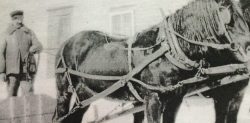Extracted from A Short History of Carleton County, New Brunswick, T.C.L. Ketchum, Publisher: Sentinel Publishing Co. Ltd., Woodstock, New Brunswick, pp. 66-67
Various efforts were made towards what may be termed social settlement, groups of people kindred in social and religious affiliations. Appropriate instances of this policy are found in the Glassville, Johnville, Knowlesville and Beaufort settlements. Governor Manners-Sutton seems to have been the originator of this scheme, which worked out well in the settlements named. Perhaps it would have been better had it been more generally adopted, that we might not have the unhappy contrast of three or four churches and ministers in a small community on the one hand, and long stretches where there is neither minister nor church on the other, and where little children hardly know what God means.
Glassville came into being as the result of the activity of a Presbyterian minister, Rev. Charles Gordon Glass of Aberdeen, Scotland. A tract of 10,000 acres was set apart, with the expectation that one hundred families of Presbyterians from Scotland would occupy one hundred acres each, on the reasonable payment to the government of three shillings an acre. The first arrivals to form the pioneers of this new thriving settlement were the McIntosh, Joyner and Bisset families. Glass went to Scotland to further his settlement idea and to lecture to the people on the advantages of life in New Brunswick. There appears to have arisen misunderstanding between the government and Glass over his duties and remuneration, and when some of the settlers arrived, they claimed that things had been misrepresented, but the difficulty was adjusted. In the summer of 1861 between fifty and sixty stalwart settlers arrived from Scotland to join the community already established and as time went by, more were added. Glassville still remains distinctively though not exclusively Presbyterian. Glass was evidently a man of enterprise, for besides his settlement idea he conceived the project of a Presbyterian college in Woodstock, did, in fact, erect a building, which, while never devoted to the high purpose for which it was intended, was some time used as a private seminary conducted by Glass, and on the establishment of the Free School System (1871) was bought by the trustees. The Grammar school and other grades were long held in the “College School,” which stood on the site of the Fisher Memorial. It was soon found advisable to lay out another ten thousand acres to accommodate the incoming settlers.
As early as 1860 a mill had been built by one Joseph N. Farley on the Coldstream, at the threshhold of Central Glassville, now bearing the name of Esdraelon. Energetic efforts were made to extend the clearings and among the first to take a hand were John Alexander and David Miller. The settlement was augmented by the arrival of George B. Reid, John Simpson, John Millie, Archie Scott, James Lawson, William Love, Hugh Miller and others, while a section in West Glassville known as Ketchum Ridge, was settled by immigrants from the State of Maine. The earliest resident minister was Rev. Samuel Bernard who covered a large section of the country as well as the Glassvilles. When Aberdeen was formed into a separate parish, the first councilors to represent it were James N. Farley and James L. Simpson. Foreston and the back sections of Aberdeen were outgrowths, largely, of the Glassville settlement. The road from the river out to Glassville is somewhat hilly, but is improving all the time, by reason of the automobilist, who knows no politics, when roads are concerned. The wonderful views across the country from the hills, as you take in the Johnville and Knowlesville settlements in the distance at a glance, repays the extra energy devoted to the climbing. Moreover, even the Scot of the second and third generation has a liking for hills.
***************************************
